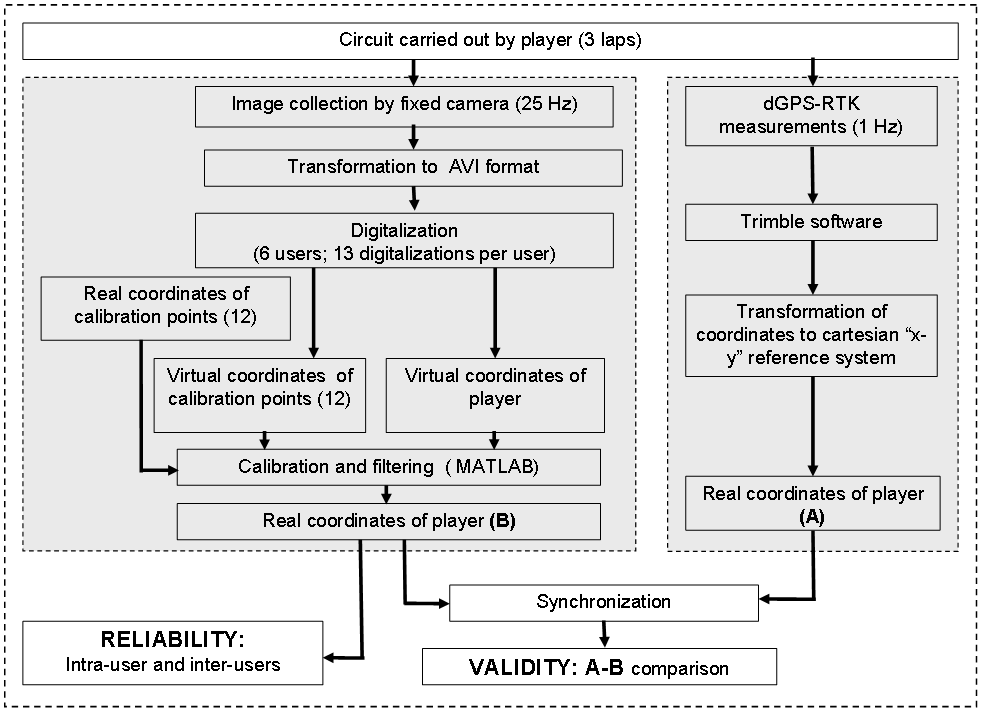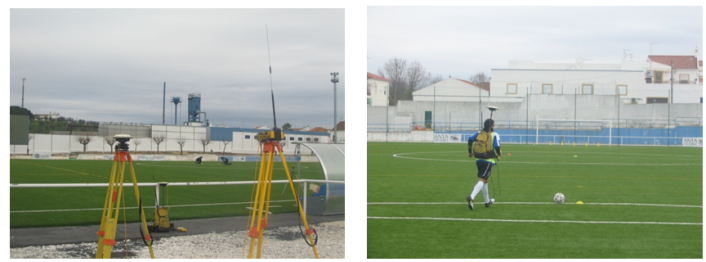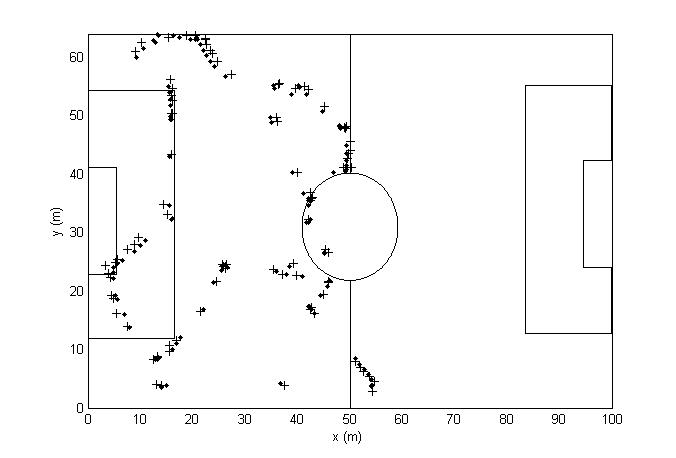-
Paper Information
- Next Paper
- Previous Paper
- Paper Submission
-
Journal Information
- About This Journal
- Editorial Board
- Current Issue
- Archive
- Author Guidelines
- Contact Us
International Journal of Sports Science
p-ISSN: 2169-8759 e-ISSN: 2169-8791
2014; 4(6A): 28-34
doi:10.5923/s.sports.201401.04
Validation of a Manual Position Tracking Software (TACTO) to Quantify the Football Movements
João Serrano, Shakib Shahidian, Orlando Fernandes
School of Sciences and Technology, University of Évora, Évora Codex, Portugal
Correspondence to: João Serrano, School of Sciences and Technology, University of Évora, Évora Codex, Portugal.
| Email: |  |
Copyright © 2014 Scientific & Academic Publishing. All Rights Reserved.
The aim of this study was to present a validation protocol using a global positioning system with real-time differential correction (dGPS) to assess the validity and the reliability of a semi-auto tracking software (TACTO) used to quantify the movement patterns of football players. In order to obtain the 2D coordinates of the movements of a player from the virtual coordinates, the TACTO software was used twice, first for calibration (the virtual coordinates of a set of reference points at the game surface were collected, corresponding to points with known real coordinates) and then for digitalization (reconstruction of coordinates). The reconstruction of virtual coordinates of the player into real coordinates was carried out using DLT-2D, with algorithms developed in MATLAB’ software routines. The coordinates obtained by this methodology were compared to the coordinates obtained by dGPS receiver. The validity and the intra-user and inter-users reliability of the methodology used were proved by all the statistical parameters used (the relative technical error of measurement (ETM), the Pearson coefficient (r), and the intra-class correlation coefficient ( ICC)).
Keywords: TACTO, Reliability, Validity
Cite this paper: João Serrano, Shakib Shahidian, Orlando Fernandes, Validation of a Manual Position Tracking Software (TACTO) to Quantify the Football Movements, International Journal of Sports Science, Vol. 4 No. 6A, 2014, pp. 28-34. doi: 10.5923/s.sports.201401.04.
Article Outline
1. Introduction
- Since Reilly and Thomas [1], early study in monitoring football players, the interest and timeliness of this topic has been demonstrated by research conducted by several teams [2-12] over the last decades. Several published works have focused on circuits designed to simulate typical situations of a football game, characterized by movements at different speeds, from walking to maximum speed (sprint), frequently without ball, including quick change of direction [1, 6, 13].The two main systems used for game analysis, in the different sports, are based on video images analysis and GPS technology [14]. The camera calibration procedures and the tri-dimensional reconstruction of the coordinates were initially proposed by Abdel-Aziz and Karara [15] and are known as Direct Linear Transformation (DLT). The position of an object on the plane, in relation to a reference, is defined with the help of two independent coordinates, such as the rectangular coordinates (x and y), in relation to the time (t). The aim of this approach is to transform the images in order to obtain two-dimensional spatial coordinates (2D-DLT), which results in a simplification of the parametric equations proposed by Abdel-Aziz and Karara [16], thus eliminating the need for camera synchronization [17].The difficulty in obtaining the information in real time and errors during the image digitalization is an important disadvantage of this method [3]. Small systematic errors can be introduced by the different techniques used, at the level, for example, of the eyes - hand coordination, of the visual sharpness and of the standards of concentration [3]. Furthermore, traditional methods of motion analysis require operators tracking the positions within the video, which is extremely labour intensive and a major step back in relation to existing auto-tracking systems [6].Various commercial systems based on processing of video images exist on the market. The systems for the collection and processing of information in team sports can be relatively expensive in particular the "AMISCO Pro®" and the "ProZone®" systems [6]. The need for permanent placement of various cameras in the stadium at previously studied fixed positions, and the associated high cost are limitations to their acquisition and open new perspectives for alternative systems of significantly lower costs. The “TACTO” (“Tool for Applied and Contextual Time-series Observation”) software developed by Fernandes [18] in Visual Basic – version 7.0 for analysis of the positions is a relatively economical and simple solution. In general, these systems require the validity and reliability evaluation. Reliability and validity are very important for measuring error during digitalization and coordinates transformation [19-20]. Jennings et al. [21] and Waldron et al. [22] are examples of previous published test protocols to evaluate the validity and reliability of tracking systems. Carling et al. [6] stressed that it is important to evaluate intra-user and inter-user reliability of the video images analysis system in each kind of exercise in which displacement is measured. The study of Duthie et al. [20] is one of the few published papers dedicated exclusively to the evaluation of the reliability of the digitalization process. Dobson and Keogh [19] and Carling et al. [6] have expressed some concerns about the scientific validity of the accuracy and the reliability of different systems of obtaining coordinates by digitalization of video images. Several studies have tested the validity of commercial GPS receivers to characterize the types of movements made by football players [14]. Coutts and Duffield [23] concluded, however, that this system can not be sufficiently accurate in situations involving high speeds or frequent changes in speed or direction. On the other hand, the GPS technology with real-time differential correction (DGPS-RTK), used especially in works of topography provides an accuracy of a few centimeters in positioning [24], being suitable for validation of other tracking systems [2]. Therefore, the main purpose of this study was to present a validation protocol using a global positioning system with real-time differential correction (dGPS) to evaluate the "TACTO-DLT-2D" methodology for obtaining kinematic parameters for monitoring the movement patterns of the football players.
2. Material and Methods
2.1. Measurements
- The sampling of this study was made from several time series of coordinates, obtained by digitalization of video images (virtual coordinates) and coordinates obtained from the dGPS-RTK receiver (real coordinates).
2.2. Procedures
- The aim of validation (Figure 1) is to demonstrate the validity and the reliability of the system [6]. The validity consists in comparing the system under study (TACTO) with a reference system. The accuracy of dGPS technology makes it an ideal tool for this purpose [24-25].
 | Figure 1. Validation of "TACTO-DLT-2D" methodology |
 | Figure 2. Circuit courses representative of the most frequent movements of football players |
 | Figure 3. Differential correction station (dGPS) (top) and the football player equipped with mobile GPS antenna (bottom) |
2.3. Synchronization of the Systems
- Filming of the dGPS-RTK receiver screen at the end of the data collection, provided a means for establishing the temporal correspondece between the time read by the dGPS-RTK receiver and the time registered by the video camera. Thus it was possible to have the coordinates obtained by the two methods (dGPS-RTK and digitalization of video images) on the same time reference (time synchronization). Given the difference in the sampling rates (1 Hz in the case of dGPS-RTK receiver and 25 Hz in the case of the video image digitalization), a “MATLAB” routine was created that searchs and identifies the records obtained by dGPS-RTK system that correspond, in terms of sampling rates, to the coordinates obtained in the process of digitalizing of the video images in the set of three laps of the circuit completed by the football player (sampling rates synchronization).
3. Results and Discussion
3.1. Validity
- Table 1 shows the values of the coefficients of determination (r2) in linear regression analysis between the coordinates obtained by dGPS receiver and coordinates obtained by digital video images (mean of 78 digitalizations). The values were 0.998 for the x-coordinate and 0.999 for the y-coordinate. The ETM changed from 2.01 to 2.53 % for the x-coordinate and from 1.09 to 2.08 % for the y-coordinate.
|
 | Figure 4. Coordinates collected by dGPS receiver (.) and video images digitalization (+), during one of the circuit laps made by the football player |
3.2. Reliability
- The correlation between thirteen digitalizations of each participant (intra-user reliability) was significant and the medium value of the correlation coefficient of Pearson (r) for intra-user and inter-users correlation changed between 0.993 ± 0.007 and 0.998 ± 0.001 for the x-coordinate and between 0.952 ± 0.064 and 0.991 ± 0.007 for the y-coordinate (Table 2).
|
|
|
3.3. Study Limitations
- Since in official competitions, the athletes are not allowed to carry electronic components, and the fact that the GPS antenna looks very hindering for a football player, an actual game was not considered for the collection of data, which one can be pointed out as a major limitation of this study. The randomness or unpredictability of the game allows for a diversity of typical situations in real context, which would lead to a more ecological approach.On the other hand, the different sampling rates used by the two systems (1 Hz in the case of dGPS-RTK receiver and 25 Hz in the case of the video image digitalization), may pose greater difficulty in the synchronization process.Finally, the "TACTO-MATLAB" methodology used in this study, based on the reconstruction of coordinates in two dimensions ("2D-DLT"), obtained from images captured by a fixed video camera located above the football field is a simplification of the "3D-DLT" methodology applied to sports where the movement occurs essentially in one plane, as is the case of football. However, this approach does not consider the movements that occur in the vertical plane, which may be especially important in a specific analysis of the movement, particularly in the evaluation and improvement of technical skills.
4. Conclusions
- The linear regression analysis show a good fit between the linear model and the experimental data, which, associated with low values of dispersion indicator (ETM), demonstrate a good degree of approximation between coordinates obtained by digitalization and the real path values. The high values obtained for the intra-user and inter-users correlation coefficients and ICC between digitalization associated with the low ETM values also demonstrate the reliability of this methodology.The validity and reliability of the low-cost “TACTO-DLT-2D” system for obtaining coordinates of football players, demonstrated by all the statistical parameters used, including regression analysis, correlation and error of determination, opens good perspectives for the generalized use of the methodology in other sports and in places such as inside of buildings (futsal, handball, basketball, etc.) where it is not possible to use GPS receivers due to inaccessibility of satellite signals inside buildings.
References
| [1] | Reilly, T., and Thomas, V., 1976, A motion analysis of work-rate in different positional roles in football match-play., J. Hum. Movement Stud., 2, 87-97. |
| [2] | Terrier, P., and Schutz, Y., 2005, How useful is satellite positioning system (GPS) to track gait parameters? A review. J. Neuro Engineering and Rehabilitation, 2, 28-38. |
| [3] | Edgecomb, S. J., and Norton, K. I., 2006, Comparison of global positioning and computer-based tracking systems for measuring player movement distance during Australian Football. J. Sci. Med. Sport, 9(1), 25-32. |
| [4] | Roberts, S., Trewartha, G., and Stokes, K., 2006, A comparison of time-motion analysis methods for field-based sports. J. Sports Physiol. Perform., 1, 388-399. |
| [5] | Barros, R. M. L., Misuta, M. S., Menezes, R. P., Figueroa, P. J., Moura, F. A., Cunha, S. A., Anido, R. and Leite, N., 2007, Analysis of the distances covered by first division Brazilian soccer players obtained with an automatic tracking method. J. Sports Sci. Med., 6, 233-242. |
| [6] | Carling, C., Bloomfield, J., Nelsen, L., and Reilly, T., 2008, The role of motion analysis in elite soccer. Contemporary performance measurement techniques and work rate data. Sports Med., 38(10), 829-862. |
| [7] | Barbero-Alvarez, J. C., Soto, V. M., Barbero-Alvarez, V., and Granda-Vera, J., 2008, Match analysis and heart rate of futsal players during competition. J. Sports Sci., 26(1), 63-73. |
| [8] | MacLeod, H., Morris, J., Nevill, A., and Sunderland, C., 2009, The validity of a non-differential global positioning system for assessing player movement patterns in field hockey. J. Sports Sci., 27(2), 121-128. |
| [9] | Hill-Haas, S., Dawson, B. T., Coutts, J. A., and Rowsell, G. J., 2009, Physiological responses and time-motion characteristics of various small-sided soccer games in youth players. J. Sports Sci., 27(1), 1-8. |
| [10] | Brewer, C., Dawson, B., Heasman, J., Stewart, G., and Cormack, S., 2010, Movement pattern comparisons in elite (AFL) and sub-elite (WAFL) Australian football games using GPS. J. Sci. Med. Sport, 13(6), 618-623. |
| [11] | Castellano, J., Alvarez-Pastor, D., and Bradley, P. S., 2014, Evaluation of research using computerised tracking systems (Amisco(®) and Prozone (®)) to analyse physical performance in elite soccer: a systematic review. Sports Med., 44(5), 701-712. |
| [12] | Magel, R., and Melnykov, Y., 2014, Examining influential factors and predicting outcomes in european soccer games. Int. J. Sports Sci., 4(3), 91-96. |
| [13] | Reilly, T., and Gilbourne, D., 2003, Science and football: a review of applied research in the football codes. J. Sports Sci., 21(9), 693-705. |
| [14] | Randers, M., Mujika, I., Hewitt, A., Santisteban, J., Bischoff, R., Solano, R., Zubillaga, A., Peltola, E., Krustrup, P., and Mohr, M., 2010, Application of four different football match analysis systems: A comparative study. J. Sports Sci., 28(2), 171-182. |
| [15] | Abdel-Aziz, Y. I., Karara, H. M., 1971, Direct linear transformation from comparator coordinates into object-space coordinates. Proc. ASP/UI Symp. On Close-range Photogrammetry (Urbana, 1995). American Society of Photogrammetry, Falls Church (Va/USA), pp. 1-18. |
| [16] | Misuta, M. S., 2004, Rastreamento automático de trajetórias de jogadores de Futebol por videografia: validação do método e análise dos resultados. Tese de Mestrado, Faculdade de Educação Física, Universidade Estadual de Campinas, Campinas, Brasil. |
| [17] | Hopkins, W. G., 2000, Measures of Reliability in Sports Medicine and Science. Sports Med., 30(1), 1-15. |
| [18] | Fernandes, O., 2008, Tool for Applied and Contextual Time-series Observation (“TACTO”). Oral Presentation of the 2nd Internacional Congress of Complex Systems in Sport, 4-8 November, Madeira, Portugal. |
| [19] | Dobson, B. P., Keogh, J. W. L., 2007, Methodological Issues for the Application of Time-Motion Analysis Research. Strength Cond. J., 29(2), 48-55. |
| [20] | Duthie, G., Pyne, D., and Hooper, S., 2003, The reliability of video based time motion analysis. J. Hum. Movement Stud., 44, 259-272. |
| [21] | Jennings, D., Cormack, S., Coutts, A. J., Boyd, L., and Aughey, R. J., 2010, The validity and reliability of GPS units for measuring distance in team sport specific running patterns. Int. J. Sports Physiol. Perform., 5(3), 328-341. |
| [22] | Waldron, M., Worsfold, P., Twist, C., and Lamb, K., 2011, Concurrent validity and test-retest reliability of a global positioning system (GPS) and timing gates to assess sprint performance variables. J. Sports Sci., 29(15), 1613-1619. |
| [23] | Coutts, A. J., and Duffield, R., 2010, Validity and reliability of GPS devices for measuring movement demands of team sports. J. Sci. Med. Sport, 13(1), 133-135. |
| [24] | Morales, Y., and Tsubouchi, T., 2007, DGPS, RTK-GPS and StarFire GPS Performance Under Tree Shading Environments. In: Proceedings of the IEEE International Conference on Integration Technology, Shenzhen, China, pp. 519-524. |
| [25] | Witte, T. H., and Wilson, A. M., 2004, Accuracy of non-differential GPS for the determination of speed over ground. J. Biomech., 37(12), 1891-1898. |
| [26] | Winter, D., 2004, Biomechanics and Motor Control of Human Movement. Third Edition, John Wiley & Sons, Inc., pp. 40-44. |
| [27] | Serra, G, and Bottura, C., 2007, An IV-QR Algorithm for Neuro-Fuzzy Multivariable Online Identification. IEEE T. Fuzzy Syst., 15(2), 200-210. |
| [28] | McInnes, S., Carlson, J. S., Jones, C. J., McKenna, M. J., 1995, The physiological load imposed on basketball player during competition. J. Sports Sci., 13(5), 387-397. |
| [29] | Collins, J. J., and De Luca, C. J., 1993, Open-loop and closed-loop control of posture: A random-walk analysis of center-of-pressure trajectories. Exp. Brain. Res., 95(2), 308-318. |
| [30] | Chiari, L., Cappello, A., Lenzi, D., and Croce, U., 2000, An improved technique for the extraction of stochastic parameters from stabilograms. Gait Posture, 12(3), 225-234. |
 Abstract
Abstract Reference
Reference Full-Text PDF
Full-Text PDF Full-text HTML
Full-text HTML



